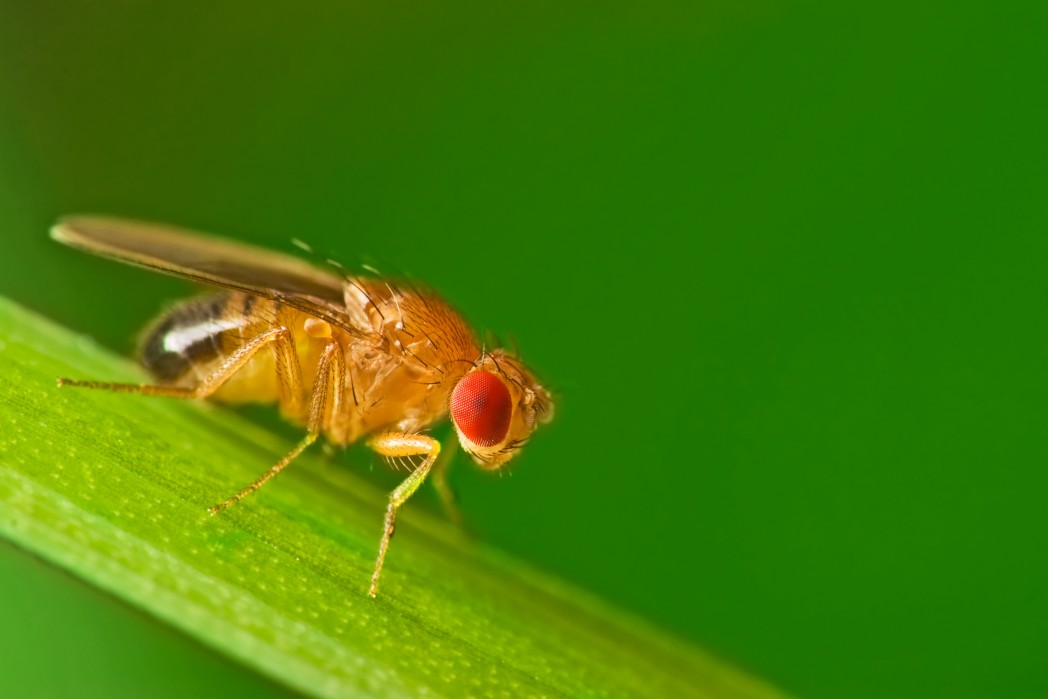Fruit Fly Model Cost-effective for Screening Obesity-related Genes

Genetic screening in fruit flies is a relatively simple, cost-effective, and rapid process with the potential to increase understanding of genetic obesity development in humans.
Specifically, the fruit fly is a workable model organism for high-throughput screening of candidate genes associated with eating behavior and obesity in humans, according to a recent study, “A multicomponent screen for feeding behaviour and nutritional status in Drosophila to interrogate mammalian appetite-related genes,” which was published in the journal Molecular Metabolism.
Genetic studies in humans and in mice have identified brain circuits associated with the regulation of appetite and obesity. The leptin-melanocortin signaling pathway in a brain area called the hypothalamus is a well-characterized circuit in which genetic mutations cause diverse obesity disorders.
Genome-wide association studies (GWAS), an approach used to analyze genetic variations associated with diseases, have identified more than 300 genetic sites linked to changes in body mass index (BMI). Many of the genes near these sites are highly expressed (active) in the brain and are involved in the leptin-melanocortin pathway.
Although their exact functions are unknown, mutations in these genes affect food intake. The high cost and slow pace of research pose challenges for scientists in discerning the function of BMI-related genes involved in appetite regulation.
The fruit fly (Drosophila melanogaster) is a widely used model organism for biological research. Although the species is far from humans evolutionarily, about 75% of the genes associated with inherited human diseases have a fruit fly version. Importantly, fruit fly research is significantly faster and less expensive than other animal models, due to their short life cycle, high reproduction rates, and relatively inexpensive husbandry.
For the study, researchers at the University of Cambridge used fruit flies to screen genes related to energy homeostasis — the coordination of food intake and energy expenditure. They used genetic knockdowns to reduce expression of genes specifically in nerve cells. Then, they screened for feeding behaviors to determine which genes regulate appetite using multiple assays that measure feeding behaviors, which were validated using genes known to modulate these behaviors in the fruit fly.
The investigators developed a scoring system (0–1) to evaluate feeding behavior, in which a score of 0.8 or higher indicated a “gene of interest,” and a score of 1 represented the most pronounced behavioral traits.
The assays were used to screen 56 fruit fly genes, all corresponding to human genes located near previously identified BMI-associated genetic sites. A total of 15 fly genes yielded a score of 0.8 or above, including some with known roles in energy homeostasis — ATXN2L, PCSK1, NEGR1 — and some without such a role NRXN3.
Specifically, Atx2 — ATXN2L in humans — had the highest score at 0.99, with flies with reduced nerve cell Atx2 eating significantly less. In previous studies, mice lacking the gene had adult-onset obesity, suggesting ATXN2L may play a role in energy homeostasis. In addition, while a global loss of RPL27A expression was lethal in mice, neuron-specific reduction in flies resulted in a score of 0.88, suggesting the gene is involved in the control of food intake.
The group then used fly lines in which the expression of a target gene is eliminated. Fly larvae lacking five genes showed abnormally reduced feeding following a fast. In adult flies, only the absence of PCSK1 exhibited obesity traits, consistent with the role of PCSK1 in genetic obesity in humans.
Next, the researchers screened genes with key roles in appetite, from a large group previously described in nerve cells — those containing agouti-related peptide, which stimulate appetite, and proopiomelanocortin neurons that suppress food intake. A total of 157 genes were found to respond in a reciprocal manner to fasting. Among the genes with a score of 0.80 or more, two (Htr1a, Tub) have previously been linked to energy homeostasis.
“We demonstrated the utility of Drosophila as a tractable model organism in a high-throughput genetic screen for food intake phenotypes [manifestations],” the researchers wrote.
“This simple, cost-efficient strategy is ideal for high-throughput interrogation of genes implicated in feeding behaviour and obesity in mammals and will facilitate the process of reaching a functional understanding of obesity,” they added. “We were able to screen around 60 different Drosophila lines in 5 weeks, at a cost of less than £50 [$66] per gene, resulting in 30% of human genes screened being highlighted as warranting further study.”




